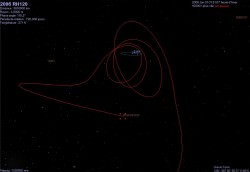[/caption]
Look up in a clear night sky. How many moons do you see? Chances are, you’re only going to count to one. Admittedly, if you count any higher and you’re not alone, you may get some funny looks cast in your direction. But even though you may not be able to actually see them, there may very well be more moons out there orbiting our planet.
For the time being, anyway.
Today, Earth has one major moon in orbit around it. (Technically the Earth-Moon system orbits around a common center of gravity, called the barycenter, but that’s splitting hairs for the purpose of this story.) At one time Earth may have had two large moons until the smaller eventually collided into the larger, creating the rugged lump we now call the farside highlands. But, that was 4 billion years ago and again not what’s being referred to here.
Right now, at his moment, Earth may very well have more than the one moon we see in the night sky. Surprise.
Of course, it would be a very small moon. Perhaps no more than a meter across. But a moon nonetheless. And there could even be others – many others – much smaller than that. Little bits of solar system leftovers, orbiting our planet even farther out than the Moon we all know and love, coming and going in short-lived flings with Earth without anyone even knowing.
This is what has been suggested by researcher Mikael Granvik of the University of Helsinki in Finland. He and his colleagues have created computer simulations of asteroids believed to be occupying the inner solar system, and what the chances are that any number of them could be captured into Earth orbit at any given time.

The team’s results, posted Dec. 20 in the science journal Icarus, claim it’s very likely that small asteroids would be temporarily captured into orbit (becoming TCOs, or temporarily captured objects) on a regular basis, each spending about nine months in up to three revolutions around Earth before heading off again.
Some objects, though, might hang around even longer… in the team’s simulations one TCO remained in orbit for 900 years.
“There are lots of asteroids in the solar system, so chances for the Earth to capture one at any time is, in a sense, not surprising,” said co-author Jeremie Vauballion, an astronomer at the Paris Observatory.
In fact, the team suspects that there’s most likely a TCO out there right now, perhaps a meter or so wide, orbiting between 5 and 10 times the distance between Earth and the Moon. And there could be a thousand smaller ones as well, up to 10 centimeters wide.
So if these moons are indeed out there, why don’t we know about them?
Put simply, they are too small, too far, and too dark.
At that distance an object the size of a writing desk is virtually undetectable with the instruments we have now.. especially if we don’t even know exactly where to look. But in the future the Large Synoptic Survey Telescope (LSST) may, once completed, be able to spot these tiny satellites with its 3200-megapixel camera.
Once spotted, TCOs could become targets of exploration. After all, they are asteroids that have come to us, which would make investigation all the easier – not to mention cheaper – much more so than traveling to and back from the main asteroid belt.
“The price of the mission would actually be pretty small,” Granvik said. And that, of course, makes the chances of such a mission getting approved all the better.
Read more on David Shiga’s article on New Scientist here.

